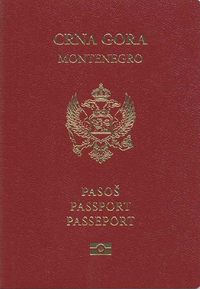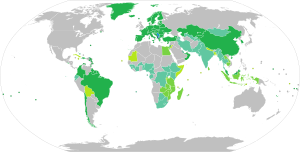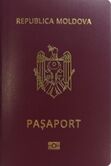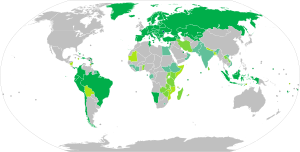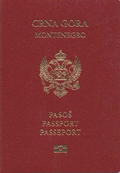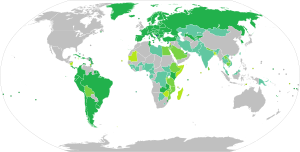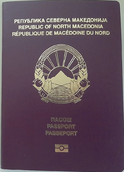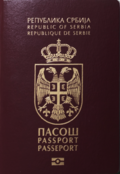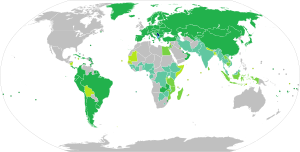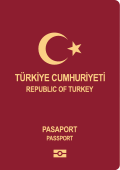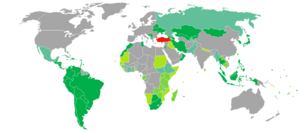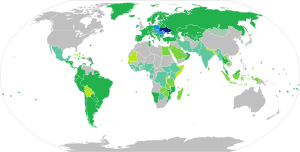Passports of European Union candidate states
Template:Infobox Geopolitical organisation
Since the 1980s, member states of the European Union have started to harmonise aspects of the designs of their ordinary passports (but not other types of passports, such as diplomatic, service and emergency passports), as well as common security features and biometrics.
Most passports issued by EU member states have the common recommended layout; burgundy in colour with the words "European Union" accompanied by the name of the issuing member state printed on the cover.[1]
Characteristics
Overall format
- Paper size B7 (ISO/IEC 7810 ID-3, 88 mm × 125 mm)
- 32 pages (passports with more pages can be issued to frequent travellers)
- Colour of cover: burgundy red or blue
Cover
Information on the cover, in this order, in the language(s) of the issuing state:
- Name of the issuing state
- Emblem of the state
- The word "PASSPORT"
- The biometric passport symbol:

First page
Information on the first page, in one or more of the languages:
- Name of the issuing state
- The word "PASSPORT"
- Serial number (may also be repeated on the other pages)
Identification page
Information on the (possibly laminated) identification page, in the languages of the issuing state plus English and French:
1. Surname 2. Forename(s) 3. Nationality 4. Date of birth 5. Sex 6. Place of birth 7. Date of issue 8. Date of expiry 9. Authority 10. Signature of holder
Following page
Optional information on the following page:
11. Residence 12. Height 13. Colour of eyes 14. Extension of the passport 15. Name at birth (if now using married name or have legally changed names)
Remaining pages
- The following page is reserved for:
- Details concerning the spouse of the holder of the passport (where a family passport is issued)
- Details concerning children accompanying the holder (name, first name, date of birth, sex)
- Photographs of the faces of spouse and children
- The following page is reserved for use by the issuing authorities
- The remaining pages are reserved for visa
- The inside back cover is reserved for additional information or recommendations by the issuing state in its own official language(s)
Overview of passports issued by the EU candidate states
| Candidate state | Passport cover | Visa requirements | Cost | Validity | Issuing authority | Latest version |
|---|---|---|---|---|---|---|
|
|
Ministry of the Interior | 2015 | |||
| 1 October 2014 | ||||||
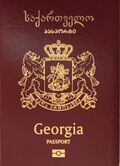
|
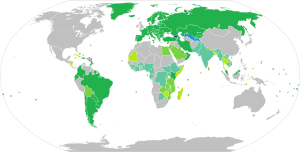
|
|
|
Ministry of Justice | 10 April
2010 | |
|
|
Public Services Agency[4] | 5 April 2023 | |||
|
|
Ministry of the Interior[5] | 2008 | |||
|
Ministry of the Interior[6] | 2019 | ||||
|
Ministry of the Interior[8] | 13 May 2016 | ||||
|
Ministry of the Interior[9] | 25 August 2022 | ||||
|
|
State Migration Service of Ukraine | 1 january 2016 |
Visa requirements for the nationals of EU candidate states for travel to the EEA, United States and Canada
Nationals of the candidate countries have varying visa arrangements with the Schengen Area and the Common Travel Area members, as well as with the United States and Canada . The following table details the requirements:
| State | Current candidate status |
Schengen Area Annex II[10] |
Common Travel Area[11] UK and Ireland |
USA – ESTA[12] | Canada |
|---|---|---|---|---|---|
| Negotiating | 90 days per 180 days[10] |
PRE-ARRIVAL VISA REQUIRED |
PRE-ARRIVAL VISA REQUIRED |
PRE-ARRIVAL VISA REQUIRED | |
| Negotiating | 90 days per 180 days[10] |
PRE-ARRIVAL VISA REQUIRED |
PRE-ARRIVAL VISA REQUIRED |
PRE-ARRIVAL VISA REQUIRED | |
| Not negotiating yet | 90 days per 180 days[10] |
PRE-ARRIVAL VISA REQUIRED |
PRE-ARRIVAL VISA REQUIRED |
PRE-ARRIVAL VISA REQUIRED | |
| Negotiating | 90 days per 180 days[10] |
PRE-ARRIVAL VISA REQUIRED |
PRE-ARRIVAL VISA REQUIRED |
PRE-ARRIVAL VISA REQUIRED | |
| Negotiating | 90 days per 180 days[10] |
PRE-ARRIVAL VISA REQUIRED |
PRE-ARRIVAL VISA REQUIRED |
PRE-ARRIVAL VISA REQUIRED | |
| Template:NMK[17] | Negotiating | 90 days per 180 days[10] |
PRE-ARRIVAL VISA REQUIRED |
PRE-ARRIVAL VISA REQUIRED |
PRE-ARRIVAL VISA REQUIRED |
| Negotiating | 90 days per 180 days[10] |
PRE-ARRIVAL VISA REQUIRED |
PRE-ARRIVAL VISA REQUIRED |
PRE-ARRIVAL VISA REQUIRED | |
| Negotiating | road map country |
PRE-ARRIVAL VISA REQUIRED |
road map country |
PRE-ARRIVAL VISA REQUIRED | |
| Negotiating | 90 days per 180 days[10] |
PRE-ARRIVAL VISA REQUIRED[lower-alpha 1] |
PRE-ARRIVAL VISA REQUIRED |
PRE-ARRIVAL VISA REQUIRED |
Current EU enlargement agenda
The enlargement of the European Union involves the accession of new member states. This process began with the Inner Six, who founded the European Coal and Steel Community (the EU's predecessor) in 1952. Since then, the EU's membership has grown to twenty-seven with the most recent expansion to Croatia in 2013 and the departure of UK in 2020.
Currently, accession negotiations are under way with several states. The process of enlargement is sometimes referred to as European integration. This term is also used to refer to the intensification of co-operation between EU member states as national governments allow for the gradual harmonisation of national laws.
To join the European Union, a state needs to fulfil economic and political conditions called the Copenhagen criteria (after the Copenhagen summit in June 1993), which require a stable democratic government that respects the rule of law, and its corresponding freedoms and institutions. According to the Maastricht Treaty, each current member state and the European Parliament must agree to any enlargement.
The present enlargement agenda of the European Union regards Ukraine , the Western Balkans and potentially Turkey, which has a long-standing application with the EU. As for the Western Balkan states, the EU had pledged to include them after their civil wars: in fact, two states have entered, three are candidates, one applied and the others have pre-accession agreements.
There are however other states in Europe which either seek membership or could potentially apply if their present foreign policy changes, or the EU gives a signal that they might now be included on the enlargement agenda. However, these are not formally part of the current agenda, which is already delayed due to bilateral disputes in the Balkans and difficulty in fully implementing the acquis communautaire (the accepted body of EU law).
Today the accession process follows a series of formal steps, from a pre-accession agreement to the ratification of the final accession treaty. These steps are primarily presided over by the European Commission (Enlargement Commissioner and DG Enlargement), but the actual negotiations are technically conducted between the Union's Member States and the candidate country.
Before a country applies for membership it typically signs an association agreement to help prepare the country for candidacy and eventual membership. Most countries do not meet the criteria to even begin negotiations before they apply, so they need many years to prepare for the process. An association agreement helps prepare for this first step.
In the case of the Western Balkans, a special process, the Stabilisation and Association Process exists to deal with the special circumstances there.
When a country formally applies for membership, the Council asks the commission to prepare an opinion on the country's readiness to begin negotiations. The council can then either accept or reject the commission's opinion (the council has only once rejected the commission's opinion when the latter advised against opening negotiations with Greece).[23]
If the council agrees to open negotiations the screening process then begins. The commission and candidate country examine its laws and those of the EU and determine what differences exist. The Council then recommends opening negotiations on "chapters" of law that it feels there is sufficient common ground to have constructive negotiations. Negotiations are typically a matter of the candidate country convincing the EU that its laws and administrative capacity are sufficient to execute European law, which can be implemented as seen fit by the member states. Often this will involve time-lines before the Acquis Communautaire (European regulations, directives and standards) has to be fully implemented.
| State |
Status |
Association Agreement |
Applied for Membership |
Candidate status |
Start of negotiations |
Screening completed |
Acquis Chapters open/closed[24] | |
|---|---|---|---|---|---|---|---|---|
| Albania | 2 Negotiating
|
2006 (SAA) | 2009 | 2014 | 2022 | – | – | |
| Bosnia and Herzegovina | 1 Negotiating
|
2008 (SAA) | 2016 | 2022 | – | – | – | |
| Georgia | Candidate | 1 July 2016 (AA) | 3 March 2022 | 14 December 2023 | – | – | – | |
| Moldova | 1 Negotiating
|
2014 (AA) | 2022 | 2022 | 14 December 2023 | – | – | |
| Montenegro | 1 Negotiating
|
2007 (SAA) | 2008 | 2010 | 2012 | 2013 | 30/3 of 33 | |
| North Macedonia | 2 Negotiating
|
2001 (SAA) | 2004 | 2005 | 2022 | – | – | |
| Serbia | 1 Negotiating
|
2008 (SAA) | 2009 | 2012 | 2014 | 2014 | 16/2 of 34 | |
| Turkey | 1 Negotiating
|
1963 (AA) | 1987 | 1999 | 2005 | 2006 | 16/1 of 33 | |
| Ukraine | 1 Negotiating
|
2014 (AA) | 2022 | 2022 | 14 December 2023 | – | – |
Gallery of EU candidate state passports
See also
- Future enlargement of the European Union
- Passports of the European Union
- Passports of the EFTA member states
- Schengen Area
- Common Travel Area
- Visa policy in the European Union
- United Kingdom visa requirements
- National identity cards in the European Economic Area
- European Economic Area
- European Free Trade Association
- United States visa
- Electronic System for Travel Authorization
- Visa policy of Canada
- List of passports
Notes
- ↑ Republic of Ireland lifted visa requirements for citizens of Ukraine in early 2022.
References
- ↑ Anonymous (6 December 2016). "Document security - Migration and Home Affairs - European Commission". https://ec.europa.eu/home-affairs/what-we-do/policies/borders-and-visas/document-security_en.
- ↑ "Putovnica / Pasoš - MUP". http://mup.ks.gov.ba/node/37.
- ↑ [1] Eliberarea pașaportului cetățeanului Republicii Moldova (PA): Informații generale
- ↑ [2] Eliberarea pașaportului cetățeanului Republicii Moldova (PA)
- ↑ "Izdavanje dokumenata". https://mup.gov.me/rubrike/izdavanje-dokumenata/85195/159612.html.
- ↑ "Archived copy". Archived from the original on 4 April 2008. https://web.archive.org/web/20080404012759/http://www.mvr.gov.mk/DesktopDefault.aspx?tabindex=5&tabid=184&parent=100. Retrieved 2008-06-13. Издавање на патна исправа
- ↑ "Putne isprave - Biometrijski pasoš". Ministarstvo unutrašnjih poslova. http://www.mup.gov.rs/wps/portal/sr/gradjani/dokumenta/putne+isprave/biometrijski+pasos.
- ↑ "Archived copy". Archived from the original on 31 August 2010. https://web.archive.org/web/20100831190053/http://www.mup.gov.rs/cms_cir/dokumenta.nsf/putne-isprave.h. Retrieved 2013-01-08. ПУТНА ИСПРАВА – ПАСОШ
- ↑ "İçişleri Bakanlığı'nın görev ve yetkileri belirlendi". https://www.aa.com.tr/tr/turkiye/icisleri-bakanliginin-gorev-ve-yetkileri-belirlendi/1199596. Retrieved 22 July 2018.
- ↑ 10.0 10.1 10.2 10.3 10.4 10.5 10.6 10.7 10.8 Consolidated version of Council regulation No. 539/2001, as of 19 December 2009, 'Annex II' countries and territories
- ↑ "Visa policy of the United Kingdom#United Kingdom visa requirements",|United Kingdom visa requirements
- ↑ "ESTA Website". https://esta.cbp.dhs.gov/esta/.
- ↑ Visa requirements for Albanian citizens
- ↑ Visa requirements for Bosnia and Herzegovina citizens
- ↑ Visa requirements for Moldovan citizens
- ↑ Visa requirements for Montenegrin citizens
- ↑ Visa requirements for citizens of North Macedonia
- ↑ Visa requirements for Serbian citizens
- ↑ Visa requirements for Turkish citizens
- ↑ Visa requirements for Ukrainian citizens
- ↑ "European Commission—Enlargement—Potential Candidates". Archived from the original on 23 October 2011. https://web.archive.org/web/20111023030335/http://ec.europa.eu/enlargement/candidate-countries/index_en.htm. Retrieved 28 October 2011.
- ↑ "European Commission—Enlargement—Potential Candidates". Archived from the original on 28 October 2011. https://web.archive.org/web/20111028143123/http://ec.europa.eu/enlargement/potential-candidates/index_en.htm. Retrieved 28 October 2011.
- ↑ Ena.lu
- ↑ Excluding Chapters 34 (Institutions) and 35 (Other Issues) since these are not legislation chapters.
External links
| Wikimedia Commons has media related to European passports. |
 |
